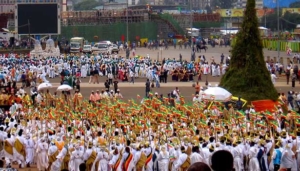The Holy Cross and its Celebration
Happy Holiday!

Deacon Zekrstos Tsegaye
The Cross is highly venerated in the lite of the Church and there are prophecies and symbolic representations about it. Accordingly, these Prophecies are stated, “The grape-vine, cut from Hasisson and planted in Golgotha became my cure.” (Psalm of Solomon 5:1-2), “Thou have set up a banner for those who fear thee, to rally to it from the bow that thy beloved may be delivered. (Ps. 59:4). The cross is symbolized through; wood with which Noah built his ark (Gen.7:1), the staff of Moses (Ex. 4:2-9) and the bronze serpent (Num. 21:9).
Before the crucifixion of Our Lord and Savior Jesus Christ, the Cross was the symbol of dead penalty, curse and humiliation (Deut. 21:23; 2 Cor. 5:21; Gal.3:13). But after the crucifixion of Our Lord, the cross has become a sign of spiritual freedom and a throne of peace. As such it has become a sign of freedom and victory for all Christians (Ps. 2:15-17).
The Cross which Constantine the Great saw in the form of light, lives as a symbol of victory. As St. Paul stated, “For the preaching of the cross is to them that perish foolishness; but unto us which are saved, it is the power of God” (1 Cor. 1:18; Phil. 3:18). The Cross of Christ has become an instrument of punishment for the death and Satan. As St. Yared stated in his hymn for the departed, the Son who created the world drove away His enemy by His Cross. The faithful believing in Christ and crossing themselves in the sign of the cross overcome demons and evil desires. The cross has also become the symbol of all Christian art.
Holy day of Mesekel /Cross/
The Meskel Holiday is celebrated on Meskerem 17 (27th of September) and Megabit 10 (19th of March). The word Meskel means, Cross and the feast commemorates the finding of the True Cross by St. Helena.
The crucifixion of the Lord, the sick were held by touching it and rubbing their bodies against the Cross. Attracted by these miracles, many became Christians. Seeing this, the Jews threw the Cross into a rubbish disposal pit and after a long time this place grew into a hill. Christians knew the area despite their inability to dig out and retrieve it.
During the invasion of Titus, (70 A.D.) all Christians left Jerusalem and long after the site of the city was changed, it became difficult to locate the place where the Cross was buried. Because of this, it remained buried for more than three hundred years.
In the 4th century, (327 A.D.) the mother of King Constantine, Queen Helena, made a journey to Jerusalem to find the Cross. But she could not trace the place for no one could tell her the exact location. Since the finding of the Cross was God’s Will, a certain old man by the name of Kiriakos (Kirakos Yared’s Hymn Book of Helena) sympathizing with her search, advised her as follows: “You need not tire out yourself and others in vain. Make people gather wood and pile it. Put incense on it and burn it. Following where the smoke drifts, dig and you will find out the Cross,” (Sinksar of Megabit (March) 10 E.C.).
She did all that she was told. The site where the Holy Cross was buried (Yared’s Hymn Book of Helena). She then dug and found out the Cross.
The Ethiopian Hymnologist, St. Yared has praised this event with the verse, “The Wooden Cross which was buried at Golgotha by the Jews is found today.” (Yared’s Hymn Book of Helena). This event is also celebrated everywhere in the Christian world. But in Ethiopia, it is celebrated with great spiritual feeling and traditional sentiments.
The Meskel Holiday falls during the beginning of the Ethiopian spring and this makes it very colorful. On Meskerem 16 (September 26th), in the cities, villages and the surrounding areas, people bring torches of twigs called ‘Chibo’ and wood to ‘Meskel Square’, to form the ‘Demera’ (bundles of branches of wood and twings). The priests perform prayers in front of the Demera and sing,” Meskel has illuminated, and it decorated the sky with stars circle the Demera followed by a huge procession which circles it singing, “Iyoha Abebaye Meskerem Tebaye.” (Behold, Meskerem has dawned and the flowers have blossomed). People at home also light ‘chibbos’ and make merry.
On the 17th morning the Demera is lit. However in Addis and in some other places, it is lit on the evening of the 16th. Since prayers have been said over the Demera, people make a sign of the cross on their forehead with the ashes and spray it over their cattle.
Since Helena started digging on Meskerem 17 (September 27th) and found the Cross on Megabit 10 (March 19th) these holidays are observed as the same holiday.
Since the icon and the cross occupy a prominent place in the spiritual life of Christians, the Ethiopian Orthodox Tewahido Church serves the faithful with consecrated icons and crosses. In Church services, the cross is used for blessing. Priests always keep the cross with them, give blessings with it and it is kissed by the Christians. In accordance with this, the church sings and prays as follows:-
“The Cross is our power,
The Cross is our strength,
The Cross is our ransom,
The Cross is the salvation of our soul,
The Jews denied, but we believed,
Believers are saved by the power of His Cross.
As the Psalmist said “We will worship at His footstool” (Ps. 131:7). It is therefore fitting to prostrate, to kneel down and to bow for the cross in reverence and grace. This reverence is also based on the Hymn of St. Yared (Tshome Digua) which runs, “O Master, we prostrate for Your Cross and praise your Holy Resurrection.” This is in accordance with the preaching’s of our Church.
